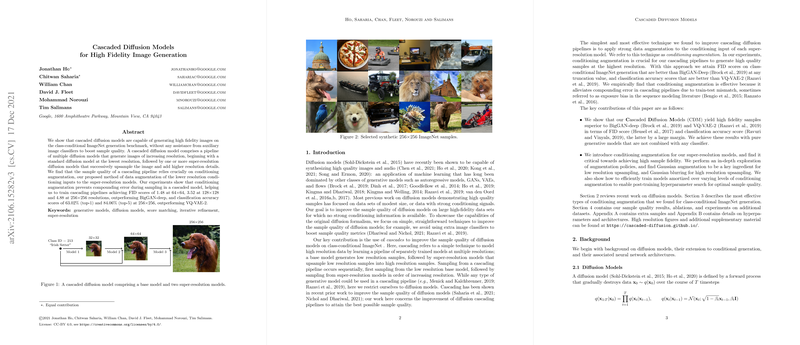Cascaded Diffusion Models for High Fidelity Image Generation
The paper presented by Ho et al. introduces Cascaded Diffusion Models (CDMs), a pipeline of multiple diffusion models that generate images of increasing resolution in a sequential manner. The authors demonstrate that CDMs are capable of achieving excellent performance on the class-conditional ImageNet generation benchmark without relying on auxiliary image classifiers to enhance sample quality. This paper makes a significant contribution to generative models, particularly in the context of image synthesis, by eliminating the need for external classifiers and focusing solely on improvements within the diffusion model paradigm.
Key Contributions
- Cascaded Diffusion Model Architecture: The authors propose a formal structure for CDMs, illustrating that it consists of a base model at the lowest resolution, followed by one or more super-resolution diffusion models. These super-resolution models upsample the image and incorporate higher resolution details in successive stages. The entire cascading process is essential for high-quality image generation at higher resolutions, such as 128128 and 256256.
- Conditioning Augmentation: A critical technique introduced in this paper is conditioning augmentation. This involves applying strong data augmentation techniques on the conditioning inputs of super-resolution models. This augmentation is crucial in preventing compounding errors during sampling and significantly improves the sample quality of CDMs. Specifically, Gaussian augmentation for low-resolution upsampling and Gaussian blurring for high-resolution upsampling were found to be the most effective.
- Numerical Results: The authors provide robust results for their CDM architecture. They achieve an FID score of 1.48 at the 6464 resolution, 3.52 at 128128, and 4.88 at 256256. These results outperform existing state-of-the-art generative models such as BigGAN-deep and VQ-VAE-2. Furthermore, the models achieve classification accuracy scores of 63.02\% (top-1) and 84.06\% (top-5) at 256256 resolution, significantly surpassing VQ-VAE-2's performance.
- Avoidance of Classifier Guidance: A notable aspect of this work is the focus on improving generative models without relying on classifier guidance. Classifier guidance involves combining the generative model with a separately trained image classifier to boost sample quality metrics. By avoiding this, the authors ensure that the improvements in FID and classification accuracy scores are purely due to enhancements in the generative model itself.
Practical and Theoretical Implications
The findings in this paper have several implications for both practical applications and the theoretical understanding of generative models. Practically, the CDM framework shows promise for applications requiring high-fidelity image synthesis, such as data augmentation, creative industries, and virtual environments.
Theoretically, this work contributes to the understanding of how cascading processes and conditioning augmentation can improve generative model performance. The insights around conditioning augmentation, in particular, highlight the importance of aligning the model's training conditions with its inference conditions to mitigate issues such as train-test mismatch or exposure bias.
Future Developments in AI
Given the potential of CDMs, future research may focus on exploring more complex conditioning augmentation strategies and extending CDMs to other domains beyond image synthesis, such as video generation or 3D model creation. Additionally, integrating CDMs with other advancements in generative models, like GANs' adversarial training techniques or VAEs' latent space interpolations, could result in further performance gains.
Another promising direction is the application of CDMs in unsupervised and semi-supervised learning scenarios, where high-quality synthetic data could bolster training datasets and improve model generalization. Finally, expanding the scalability and efficiency of CDMs to handle even higher resolutions or real-time generation tasks could open new avenues for AI-driven content creation.
Conclusion
The research on Cascaded Diffusion Models by Ho et al. presents substantial advances in the domain of high-fidelity image generation. By introducing a novel cascaded architecture and the conditioning augmentation technique, this work outperforms existing state-of-the-art models without auxiliary classifiers. This not only establishes a new benchmark in generative models but also provides solid ground for future explorations and applications of diffusion-based generative approaches.
